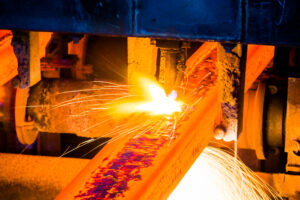The Ultimate Guide to Heat Treatment of Gear Steels
Understanding Heat Treatment of Gear Steels for Enhanced Performance Heat Treatment of Gear Steels Heat treatment is a crucial process in the manufacturing of gear steels, directly impacting their durability, strength, and performance. Proper heat treatment techniques enhance the metallurgical properties of the steel, making it ideal for high-stress applications like gears. Understanding the fundamentals […]

Understanding Heat Treatment of Gear Steels for Enhanced Performance
Heat Treatment of Gear Steels
Heat treatment is a crucial process in the manufacturing of gear steels, directly impacting their durability, strength, and performance.
Proper heat treatment techniques enhance the metallurgical properties of the steel, making it ideal for high-stress applications like gears. Understanding the fundamentals of heat treatment is essential for ensuring that the gears meet the rigorous demands of various industrial applications.
Importance of Heat Treatment in Gear Manufacturing

Gears are subject to extreme stress, friction, and wear during operation. To withstand these conditions, gear steels must possess superior hardness, toughness, and resistance to fatigue. Heat treatment is the process that imparts these desirable properties to the steel. Without it, gear steels would not be able to handle the high loads and rotational speeds required in machinery and automotive applications.
Key Heat Treatment Processes for Gear Steels
There are several heat treatment processes used in the production of gear steels, each designed to achieve specific properties. The most common processes include:
- Carburizing: A process that adds carbon to the surface layer of the steel, increasing hardness and wear resistance.
- Quenching: Rapid cooling of the steel to transform its microstructure, enhancing hardness and strength.
- Tempering: Heating the quenched steel to a lower temperature to reduce brittleness while maintaining hardness.
- Nitriding: Introducing nitrogen to the surface of the steel to form a hard, wear-resistant layer.
Each of these processes plays a vital role in achieving the desired properties of the gear steel, ensuring optimal performance in service.
Carburizing: Enhancing Surface Hardness
Carburizing is one of the most widely used heat treatment processes for gear steels. This process involves heating the steel in a carbon-rich environment, allowing carbon atoms to diffuse into the surface. The result is a hardened outer layer that can withstand significant wear and tear while maintaining a tougher, more ductile core. This combination of hardness and toughness is critical for gears that operate under high loads.
The carburizing process typically occurs at temperatures between 900°C and 950°C. After carburizing, the gear steel is usually quenched to lock in the hard surface layer. The depth of the carburized layer can be controlled by adjusting the time and temperature of the process, allowing for customization based on the specific requirements of the gear.
Quenching: Achieving Maximum Hardness
Quenching is a rapid cooling process that is essential for achieving the maximum hardness in gear steels. After carburizing, the steel is heated to a high temperature and then rapidly cooled, typically in oil or water. This sudden temperature change transforms the microstructure of the steel, creating a hard, martensitic phase.
However, quenching can also introduce stresses into the steel, making it more brittle. To mitigate this, the quenched steel is often subjected to tempering, a subsequent heat treatment process that balances hardness with toughness.
Tempering: Balancing Hardness and Toughness
Tempering is a critical step in the heat treatment of gear steels, aimed at reducing the brittleness introduced by quenching. During tempering, the quenched steel is reheated to a lower temperature, usually between 150°C and 650°C, depending on the desired properties. This process allows some of the internal stresses to relax, reducing the risk of cracking while maintaining a high level of hardness.
Tempering is particularly important for gears that will be exposed to cyclic loading, as it improves the steel’s resistance to fatigue. The precise temperature and duration of tempering are carefully controlled to achieve the optimal balance between hardness and toughness.
Nitriding: Advanced Surface Hardening
Nitriding is an advanced heat treatment process that introduces nitrogen into the surface of the steel, forming a hard, wear-resistant layer. Unlike carburizing, nitriding is typically performed at lower temperatures, around 500°C to 550°C, which means it does not require quenching. This results in minimal distortion of the gear steel, making nitriding an ideal choice for precision components.
The nitrided layer is extremely hard, offering excellent resistance to wear and fatigue. This makes nitriding particularly suitable for gears that operate under high-stress conditions, where long-term durability is essential.
Factors Influencing Heat Treatment Outcomes
The success of heat treatment processes depends on several factors, including the composition of the steel, the specific heat treatment parameters, and the cooling method used. Even slight variations in these factors can significantly impact the final properties of the gear steel.
- Steel Composition: The alloying elements in the steel, such as carbon, chromium, and molybdenum, play a crucial role in determining the outcome of heat treatment. These elements influence the hardenability, toughness, and wear resistance of the steel.
- Heat Treatment Parameters: The temperature, time, and atmosphere used during heat treatment must be carefully controlled to achieve the desired properties. Deviations from the optimal parameters can lead to issues such as insufficient hardness or excessive brittleness.
- Cooling Method: The cooling rate during quenching has a direct impact on the microstructure of the steel. Faster cooling rates generally produce harder, but more brittle, steels, while slower cooling rates result in tougher, but softer, steels.
Understanding these factors is essential for optimizing the heat treatment process and ensuring that the gear steel meets the required performance standards.
Common Challenges in Heat Treatment of Gear Steels
While heat treatment is a powerful tool for enhancing the properties of gear steels, it also presents several challenges. Some of the most common issues include:
- Distortion: Rapid cooling during quenching can cause the steel to warp or distort, leading to issues with dimensional accuracy. This is particularly problematic for precision gears, where even minor deviations can affect performance.
- Cracking: The stresses introduced during quenching can sometimes lead to cracking, especially if the steel is not properly tempered afterward. Cracking is a serious issue that can compromise the integrity of the gear.
- Over- or Under-Hardening: Achieving the correct hardness is critical for gear performance. Over-hardened gears can be too brittle, while under-hardened gears may lack the necessary wear resistance.
To address these challenges, manufacturers must carefully control the heat treatment process, from the initial selection of steel to the final cooling and tempering stages.
Benefits of Proper Heat Treatment in Gear Steels
When properly executed, heat treatment can significantly enhance the performance and longevity of gear steels. The key benefits include:
- Improved Wear Resistance: Heat treatment processes like carburizing and nitriding create hard, wear-resistant surfaces that protect the gear from abrasion and surface damage.
- Enhanced Strength and Toughness: Quenching and tempering processes optimize the internal structure of the steel, providing a balance of strength and toughness that is critical for withstanding high loads.
- Extended Gear Life: By improving the wear resistance and toughness of the gear steel, heat treatment extends the service life of gears, reducing the need for frequent replacements and maintenance.
- Increased Fatigue Resistance: Proper heat treatment enhances the steel’s resistance to fatigue, allowing gears to perform reliably under cyclic loading conditions.
Heat treatment is an essential process in the manufacturing of gear steels, playing a pivotal role in determining the final properties of the gears. By carefully selecting and controlling the heat treatment processes, manufacturers can produce gear steels that offer superior performance, durability, and longevity.
Whether through carburizing, quenching, tempering, or nitriding, heat treatment ensures that gear steels are capable of meeting the demanding requirements of modern industrial applications.

